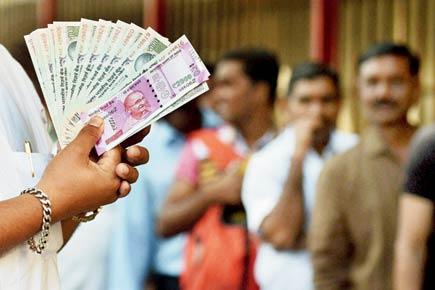India's economy should grow between 6.75 percent and 7.5 percent in the financial year beginning on April 1, a government report forecast on Tuesday


ADVERTISEMENT
Representational picture
New Delhi: India's economy should grow between 6.75 percent and 7.5 percent in the financial year beginning on April 1, a government report forecast on Tuesday.
The Economic Survey, which sets the scene for Finance Minister Arun Jaitley's fourth annual budget on Wednesday, also said the mplementation of wage hikes and muted tax receipts would put pressure on the fiscal deficit in 2017/18.
The survey was prepared by the finance ministry's chief economic adviser Arvind Subramanian.
Here are the highlights of the report:
Growth
* 2017/18 GDP growth seen between 6.75 and 7.5 percent year on year
* GDP growth rate at constant market prices for the current year 2016/17 is placed at 7.1 percent
* The federal statistics office's estimate of 7.1 percent growth for 2016/17 likely to be revised downwards
* Service sector is estimated to grow at 8.9 percent in 2016/17
* Industrial growth rate expected to moderate to 5.2 percent in 2016/17 from 7.4 percent in 2015/16
* The agriculture sector is estimated to grow at 4.1 percent in 2016/17 as opposed to 1.2 percent in 2015/16
Fiscal deficit
* Implementation of wage hike, muted tax receipts to put pressure on fiscal deficit in 2017/18
* Need for fiscal prudence for both centre and states for fiscal health of the economy
* Fiscal windfall from low oil prices to disappear in 2017/18 - TV channels
Inflation
* The average consumer price index (CPI) inflation rate declined to 4.9 percent in 2015/16 from 5.9 percent in 2014/15
* CPI-based core inflation has remained sticky in the current fiscal year averaging around 5 percent
* Oil prices, seen rising by one-sixth in 2017/18 over 2016/17 prices, could dampen India's economic growth
Demonetisation
* Remonetisation will ensure that the cash squeeze is eliminated by April 2017
* Supply of currency should follow actual demand and not be dictated by official estimate of desirable demand
* Government windfall arising from unreturned notes should be deployed towards capital spending
Monetary Policy
* Sharp rise in prices in 2017/18 may cap monetary easing headroom - ET NOW on Twitter
* Market interest rates seen lower in 2017/18 due to demonetisation - ET NOW on Twitter
Government debt
* Government debt to GDP ratio in 2016 seen at 68.5 percent down from 69.1 percent in 2015
Banking
* Suggests setting up public sector asset rehabilitation agency to take charge of large bad loans in banks
* Central agency with government backing could overcome coordination and political issues on bad loans
Taxation
* Income tax rates and real estate stamp duties could be reduced
* Timetable for reducing corporate tax rate could be accelerated
Universal Basic Income
* Universal Basic Income (UBI) proposal a powerful idea, but not ready for implementation
* UBI an alternative to plethora of state subsidies for poverty alleviation; UBI would cost between 4 and 5 percent of GDP
 Subscribe today by clicking the link and stay updated with the latest news!" Click here!
Subscribe today by clicking the link and stay updated with the latest news!" Click here!






